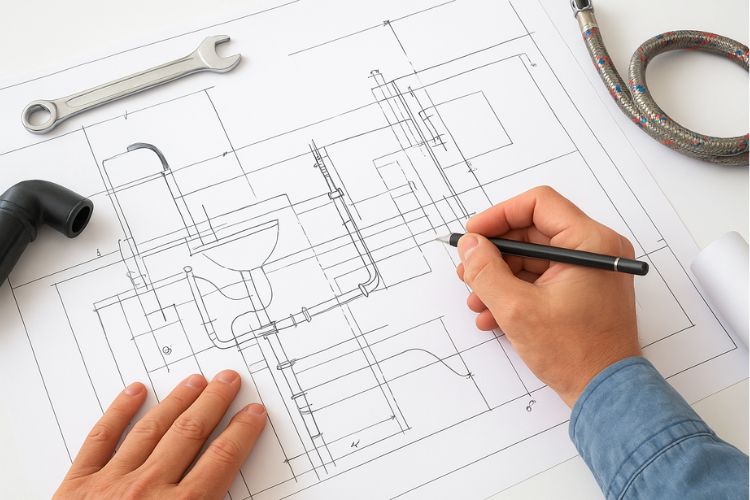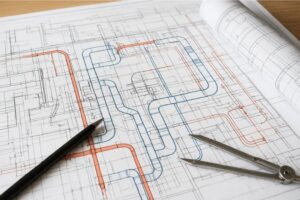Ever wondered why some construction projects glide forward smoothly while others hit costly delays? The secret often lies in the invisible blueprint guiding every pipe, valve, and fixture: Plumbing Shop Drawings. These aren’t just sketches—they’re the precise language that keeps architects, contractors, and engineers on the same page.
The Role of Plumbing Shop Drawings in Modern Projects
Think of plumbing shop drawings as a GPS for construction crews. Without them, workers might know the destination but not the turns along the way. With them, the layout of pipes, connections, and fixtures becomes crystal clear. They ensure that a project’s plumbing system is not just functional but also code-compliant and coordinated with other building systems like electrical and HVAC.
Top Benefits of Detailed Plumbing Shop Drawings
1. Precision That Prevents Costly Errors
A misplaced pipe or miscalculated slope may seem minor but can snowball into expensive repairs. Detailed shop drawings reduce this risk by leaving little room for guesswork. According to the U.S. General Services Administration, construction rework caused by design errors can add up to 5% of total project costs. That’s money no developer wants to burn.
2. Seamless Collaboration Between Teams
Plumbing is rarely a standalone system. It weaves around electrical conduits, HVAC ducts, and structural beams. By aligning with coordination drawings, plumbing shop drawings help avoid clashes before they happen. Imagine installing a water line only to realize it intersects with an HVAC duct—detailed planning prevents that headache.
3. Compliance With Codes and Standards
Municipalities and regulatory authorities demand that plumbing systems follow strict codes. Shop drawings act as a documented proof of compliance. They also simplify inspections, allowing regulators to quickly verify whether designs meet safety and efficiency benchmarks.
4. Faster Project Timelines
Time equals money in construction. When plumbers, contractors, and engineers all know exactly where components belong,
installation moves faster. A clear roadmap eliminates back-and-forth guesswork, reducing downtime and keeping deadlines on track.
5. Future-Proofing and Maintenance Ease
Years down the road, when a building requires renovations or repairs, well-documented plumbing shop drawings become invaluable. They provide a clear record of what’s behind the walls and under the floors, saving countless hours of trial-and-error for maintenance teams.
Real-World Advantages at a Glance
- Reduced rework and construction costs
- Improved coordination across multiple trades
- Fewer on-site disputes or delays
- Clearer communication with stakeholders
- Long-term value during renovations or upgrades
Plumbing Shop Drawings in the Digital Age
Today’s shop drawings aren’t just drafted on paper; they’re created using advanced CAD and BIM tools. Digital modeling allows teams to identify conflicts virtually before ground is broken. This approach mirrors how HVAC shop drawings have transformed mechanical design—bringing clarity, efficiency, and cost savings across industries.
Key Takeaways for Project Owners
- Investing in detailed drawings upfront saves far more than it costs.
- They are critical for compliance, collaboration, and communication.
- Modern projects that leverage digital shop drawings avoid common construction pitfalls.
FAQs on Plumbing Shop Drawings
What are plumbing shop drawings used for?
They are detailed plans that illustrate the layout, dimensions, and specifications of a plumbing system. They guide installation and ensure compliance with building codes.
Who prepares plumbing shop drawings?
Typically, specialized drafters or MEP detailers prepare them, often working alongside engineers and contractors for accuracy.
How do plumbing shop drawings reduce project costs?
By identifying design conflicts and inaccuracies before construction begins, they minimize rework, material wastage, and delays.
Are plumbing shop drawings required for small projects?
Even for smaller builds, shop drawings add clarity and reduce errors. While not always mandatory, they are highly recommended for efficiency.
Final Thoughts
Plumbing shop drawings may not grab the spotlight, but they’re the silent backbone of successful modern projects. From saving money to streamlining teamwork, their benefits ripple through every stage of construction. In short, investing in detail upfront pays dividends for decades.
Read More: Turning Plans into Precision: Why Coordination Drawings Matter
Blog Development Credits
This blog was a team effort fueled by smart ideas. Soumyajit Sardar picked the topic. Most content was crafted using tools like ChatGPT and Google Gemini. The Digital Piloto team polished and optimized the blog to ensure it’s clear, engaging and SEO-friendly.


